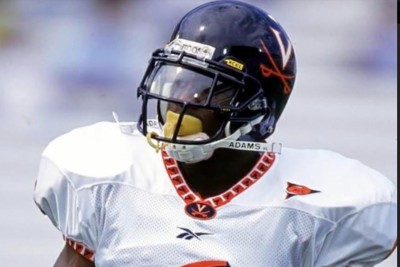By Jerry Ratcliffe

Dr. David Diduch has practiced orthopaedic surgery at the University of Virginia since 1995, with a focus on sports medicine, and has been working with Cavalier athletes as the head ortho team physician.
He sat down with yours truly and co-host Chris Graham for today’s “Good Health” podcast and talked about a topic that is dear to Wahoo fans’ collective hearts: rib injuries. UVA fans have been in the dark on quarterback Brennan Armstrong’s health status since last Saturday night when he left the BYU game in pain, pointing to his lower rib cage, apparently saying “it’s broken” as he walked off the field on his own accord.
Since then, Bronco Mendenhall has been mum on Armstrong’s condition. With this being a bye week, there has been no weekly press conference or any other access to the coach. On his radio show Tuesday night, all Mendenhall said when asked about Armstrong’s status, all the coach would say was, “Even if I [knew], I wouldn’t share it.”
Virginia hosts Notre Dame on Nov. 13 at Scott Stadium, so perhaps Mendenhall wanted to keep the Irish guessing as to what quarterback may be playing.
Diduch isn’t allowed to talk about Armstrong’s injury, but he did talk to us about rib injuries in general. Here is a partial Q&A with the good doctor (click here to listen to the full interview and our weekly Good Health podcast).
Q: What are the standard procedures when it appears that an athlete may have a rib injury?
A: “The first thing we always make sure of is that there’s not a punctured lung associated with a rib fracture. If the ribs are actually cracked, sometimes they have sharp edges, and they can puncture the lining of the lung, and then that allows air to seep out, and actually it kind of breaks the seal so that you can’t expand the lungs and breathe properly and get very short of breath.
“And, so just as a matter of protocol, we’re going to get some X-rays, and make sure they don’t have a punctured lung before they get on an airplane. That could be life-threatening. At altitude where the air pressure changes, it could make the punctured lung dramatically worse. So that’s a routine that any team would do before boarding a plane to travel.”
Q: How long does it require to heal from a rib injury?
A: “It’s rare to have a player out for the period of time that it fully takes a rib injury to heal. I mean, that would take, to be fully healed, easy, three months, certainly between two and three months. You just don’t see that. So, the vast majority of people are coming back, and it varies, a week, three weeks, five weeks. It really depends on how many ribs are broken, where they are, and how much it hurts, and that’s more of an individual thing. Most athletes are back as quickly as a week.”
Q: Is that safe?
A: “Every breath you take, especially if you’re exerting yourself and breathing deeply and straining, it’s really putting a lot of pressure and strain on those muscles, and it can be very sore. So, the first step is, are they safe? Was there any damage underneath the ribs? And then if not, then it’s a question of how sore are they? Can they stand up to more contact, and is it safe to do that?
“So, you might imagine, sometimes there’s a cracked rib, and the edges are really sharp, and they’re kind of pointing the wrong direction and you say, well, that’s not smart to play with, that’s just too risky.
“Other times, the edges are not so sharp, or the rib isn’t really displaced or sit in the cartilage part, and those things are perhaps a more safe situation and we’re not as worried about it becoming a punctured lung or something. And then it’s a matter of just how uncomfortable they are.
“The vast majority of rib fractures or rib injuries fall into that latter category where it’s OK, it’s probably safe once they can go. We try to do what we can to help players be more comfortable and protected.
“You certainly can use flak jackets, you can use padding, you can use taping, but there’s still going to be contact from opposing players, or just player-to-ground, there’s going to be contact and they’ve got to have a chance to test it out. You can’t really wait until game day to figure that one out. But that’s really what it comes down to.
“So, it’s safe and really just a matter of how much pain you can withstand, which is easy for those of us whose ribs aren’t hurting and aren’t getting hit in a football game to try to point out.”
Q: Anything else?
A: “I will say that, in general, the higher up the rib injury, the more painful it is, just because it affects the breathing so much. The lower down they are, the less painful they tend to be. So that’s one thing we see in general terms.”
For the entire Dr. Diduch interview, click here.


